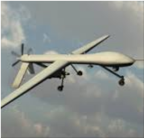Draft National Unmanned Aircraft Traffic Management Policy
The draft National Unmanned Aircraft Traffic Management Policy aims to use drones to fly alongside manned aircrafts (scheduled and non-scheduled aircrafts). The proposed policy comes in the backdrop of several instances shutting down of airports’ operations soon after the sighting of drones. The policy aims to integrate drone operations in current Air Traffic Management System while ensuring maintenance of high levels of aviation safety.
About the Policy
- The unmanned aircraft system traffic management under the policy will provide real-time situation awareness, flight planning capabilities, facilitate flight authorisation, provide weather and Terrain data. Also, it will manage the unmanned aircraft system traffic.
- The unmanned aircraft system traffic management is required as soon drones will fly alongside manned aircraft. Therefore, there is a need to maintain high levels of Aviation safety. In such cases integrating drones along with their traffic management systems will be expensive and complex. Hence, drones need a separate management systems.
Background
The draft comes in the backdrop of several global instances. In January 2019, the Heathrow Airport of London shut its operation for an hour due to Drone sighting. Similarly in 2016, Dubai airport, which is considered as the world’s busiest airport shut down its operation for about 30 minutes after a Drone sighting.
In India drones are already being used by several institutions. Recently in November 2020, the International Crops Research Institute located in Hyderabad was granted conditional exception for the deployment of drones for Agricultural Research activities. The permission was granted by the Ministry of Civil Aviation and directorate General of Civil Aviation.
Objectives of the policy
The main objective of the policy is to define how the unmanned aircraft operational scenario is to be enabled in the country. The policy has identified standard unmanned aircraft operational scenarios.
The policy mainly focuses on the unmanned aircraft operating below 2000 feet above the ground level.
Stakeholders
The policy aims to collaborate multiple stakeholders and connect them based on data exchange standards. This will boost the Information sharing between the stakeholders. The stakeholders include Airport Authority of India, air defence authorities, military authorities such as Coast Guard, Indian Airforce, Army, Indian Navy and HAL, directorate General of Civil Aviation, Bureau of Civil Aviation security, law enforcement and security agencies.
Digital Sky platform
The platform is Central to the unmanned aircraft system of India. It creates centralised, seamless and automated regulatory environment to calibrate the stakeholders in real time. It will provide unmanned aircraft system traffic management to the entire country. Also it will act as the central data archive for all flight logs and flight permissions.
No permission No take off Model of the Policy
Under the policy the digital Sky adopts no permission no takeoff model. This provides an additional layer of safety and security. It means that unmanned aircraft system cannot take off without a signed digital permission. The permission is called the permission artefact.
What is permission artefact?
The permission artefact is issued for each and every unmanned aircraft system. It includes four-dimensional authorisation information. The four dimensions are x,y,z and t. Here t is time.
Unmanned aircraft system traffic management (UTM) service providers
The remote pilots of the unmanned aircraft systems may obtain approval from the digital Sky platform through the UTMSP, UTM Service Providers. The policy has provided separate guidelines to these stakeholders.
Month: Current Affairs - December, 2020


